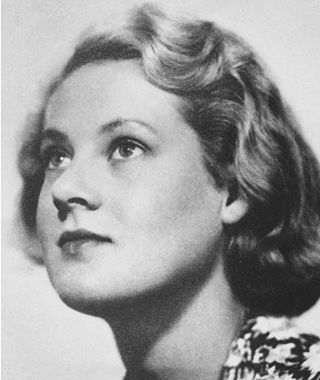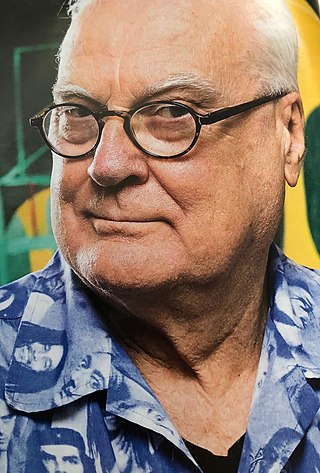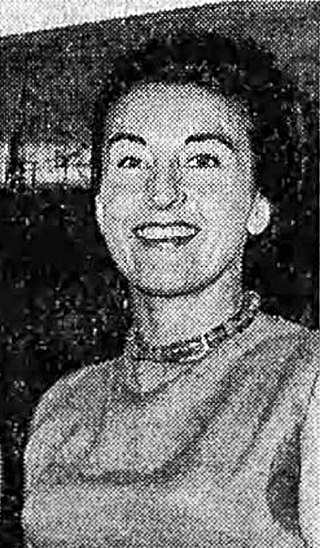Related Research Articles
John Walker is an English painter and printmaker. He has been called "one of the standout abstract painters of the last 50 years."

Joy St Clair Hester was an Australian artist. She was a member of the Angry Penguins movement and the Heide Circle who played an integral role in the development of Australian Modernism. Hester is best known for her bold and expressive ink drawings. Her work was charged with a heightened awareness of mortality due to the death of her father during her childhood, the threat of war, and her personal experience with Hodgkin's disease. Hester is most well known for the series Face, Sleep, and Love (1948–49) as well as the later works, The Lovers (1956–58).
Janet Dawson MBE is an Australian artist who was a pioneer of abstract painting in Australia in the 1960s, having been introduced to abstraction during studies in England while she lived in Europe 1957–1960 She was also an accomplished lithographic printer of her own works as well as those of other renowned Australian artists, a theatre-set and furniture designer. She studied in England and Italy on scholarships before returning to Australia in 1960. She won the Art Gallery of New South Wales Archibald Prize in 1973 with the portrait of her husband, Michael Boddy Reading. She has exhibited across Australia and overseas, and her work is held in major Australian and English collections. In 1977 she was awarded an MBE for services to art.
Grace Adela Williams Crowley was an Australian artist and modernist painter.
Elisabeth Cummings is an Australian artist known for her large abstract paintings and printmaking. She has won numerous awards including Fleurieu Art Prize, The Portia Geach Portrait Prize, The Mosman Art Prize, and The Tattersalls Art Prize. Her work is owned in permanent collections across Australia including Artbank, The Queensland Art Gallery, The Gold Coast City Art Gallery and the Art Gallery of New South Wales. She is notable for receiving recognition later in her career, considered by the Australian Art Collector as one of the 50 most collectible Australian Artists.
Robert Jacks was an Australian painter, sculptor and printmaker.
Sylvia Snowden is an African American abstract painter who works with acrylics, oil pastels, and mixed media to create textured works that convey the "feel of paint". Many museums have hosted her art in exhibits, while several have added her works to their permanent collections.

Moya Dyring was an Australian artist. She was one of the first women artists to embrace Modernism and exhibit cubist paintings in Melbourne. For several years she was a member of the modern art community known as the Heide Circle, named after the home of art collectors John and Sunday Reed, and now the Heide Museum of Modern Art. Dyring then travelled to the USA and France, where she lived most her life. Her work is held in the Heide Museum as well as the National Gallery of Australia.

Gareth Sansom is an Australian artist, painter, printmaker and collagist and winner of the 2008 John McCaughey Memorial Prize of $100,000.
Margel Ina Harris Hinder was an Australian-American modernist sculptor, noted for her kinetic and public sculptural works. Her sculptures are found outside the Australian Reserve Bank building in Martin Place, Sydney, in a memorial in Newcastle, New South Wales, and in Canberra, ACT. Her work is held in several Australian public collections.

Jean Bellette was an Australian artist. Born in Tasmania, she was educated in Hobart and at Julian Ashton's art school in Sydney, where one of her teachers was Thea Proctor. In London she studied under painters Bernard Meninsky and Mark Gertler.
Ann Thomson is an Australian painter and sculptor. She is best known for her large-scale public commissions Ebb Tide (1987) for the Sydney Convention and Exhibition Centre and Australia Felix (1992) for the Seville World Expo. In 1998 she won the [Art Gallery of New South Wales' Wynne Prize. Her work is held in national and international collections, including: the National Gallery of Australia, Canberra; Art Gallery of New South Wales, Sydney, Newcastle Art Gallery, Newcastle, Thyssen-Bornemisza Collection, Madrid and Villa Haiss Museum, Germany.
Gemma Smith is an Australian painter and sculptor, who is Sydney-based. Smith has been the recipient of numerous grants and been invited to join multiple exhibitions. She is known for her continuous experimentations with colour and abstraction. Her work is held in museum, corporate and private collections across Australia.
Sanné Mestrom is an Australian experimental and conceptual artist who works mainly in the mediums of installation and sculpture. Mestrom has a research-based practice and incorporates notions of "play" into social aspects of urban design. Since 2011, Mestrom has remade and reinterpreted motifs from the twentieth century modernist art canon. She has earned many grants and has been commissioned to execute public art, sculptures in situ. She has studied in Korea and Mexico, and is a senior lecturer at Sydney College of Art.
Savanhdary Vongpoothorn is a Laotian-born Australian visual artist. She immigrated with her parents as a seven-year old, and through studies and travel has integrated Laotian, Vietnamese and Australian influences in her art. Her art reflects cross-cultural influences in contemporary Australia as she fuses her personal experiences, dual cultures, and painterly abstraction. She has exhibited widely in Australia and Singapore, and her works are held in major state and regional galleries across Australia. She was a finalist in the Sir John Sulman Prize 2016 and the Moet & Chandon art prize in 1998. She lives and works in Canberra.
Marie Hagerty is an Australian artist, painter, sculptor and teacher.

The Field was the inaugural exhibition at the National Gallery of Victoria’s new premises on St Kilda Road, Melbourne. Launched by the director of London’s Tate gallery, Norman Reid, before an audience of 1,000 invitees, it was held between held 21 August and 28 September 1968. Hailed then, and regarded since as a landmark exhibition in Australian art history, it presented the first comprehensive display of colour field painting and abstract sculpture in the country in a radical presentation, between silver foil–covered walls and under geometric light fittings, of 74 works by 40 artists. All practised hard-edge, geometric, colour and flat abstraction, often in novel media including coloured or transparent plastic, fluorescent acrylic paints, steel and chrome. The art was appropriate to a launch of the new venue itself, designed by architect Roy Grounds, and emphatically rectilinear; cubes nested in a basalt rectangular box amongst the other buildings of the new Arts Centre, each based on a geometric solid. Echoing emerging international stylistic tendencies of the time, The Field sparked immediate controversy and launched the careers of a new generation of Australian artists.
Sandra Leveson, also known as Sandra Leveson-Meares, is an Australian painter, printmaker, and teacher.

Margaret Anne Dredge was an Australian painter and printmaker, active from the mid-1950s until 1997, and teacher of art.
Allan Mitelman is an Australian painter, printmaker and art teacher who arrived in Australia in 1953.
References
- 1 2 3 McCaughey, Patrick (2014). Strange country : why Australian painting matters. Carlton, Victoria: Miegunyah Press. ISBN 9780522861204.
- ↑ McCulloch, Alan; & McCulloch, Susan. Encyclopedia of Australian art. 1994 St Leonards, NSW : Allen & Unwin (3rd revised edition), pp. 703–704.
- ↑ "McCubbin: Last Impressions & Aida Tomescu". John McDonald. 24 October 2009. Retrieved 6 August 2020.
- ↑ Stephens, Andrew (12 December 2014). "Australian painters are still the stars of the art scene". The Sydney Morning Herald . Retrieved 6 August 2020.
- ↑ "Archived copy" (PDF). Archived from the original (PDF) on 30 March 2016. Retrieved 5 December 2015.
{{cite web}}: CS1 maint: archived copy as title (link) - ↑ Pearce, Barry. '100 Moments in Australian Painting', 2014, NewSouth Publishing, in association with the Art Gallery of NSW
- 1 2 3 "Aida Tomescu". artistprofile.com.au. 30 August 2017. Retrieved 16 August 2020.
- 1 2 "Collections Online". British Museum .
- ↑ "Aida Tomescu". aidatomescu.com. Retrieved 27 October 2020.
- ↑ "Collections Online". British Museum . Retrieved 16 August 2020.
- ↑ "ART Back to the days of abstract expressionism". The Canberra Times . 4 September 1987. p. 10. Retrieved 16 August 2020– via Trove.
- ↑ "Abstracted collection Incomplete". The Canberra Times . 16 February 1991. p. 5. Retrieved 16 August 2020– via Trove.
- ↑ "ARTS". The Canberra Times . 21 May 1994. p. 49. Retrieved 16 August 2020– via Trove.
- ↑ "Aida Tomescu: Paintings And Drawings". Drill Hall Gallery, Australian National University. Retrieved 6 August 2020.
- ↑ Grishin, Sasha. "Power in the Individual Vision", The Canberra Times , 20 October 2009
- 1 2 McDonald, John (24 October 2009). "Mccubbin: Last impressions & Aida Tomescu". Sydney Morning Herald.
- ↑ "Abstraction: celebrating Australian women abstract artists". National Gallery of Australia. Retrieved 16 August 2020.
- ↑ "No lemons here - The Spectator". Archived from the original on 24 September 2015.
- ↑ McDonald, John. "Wild and Wondrous", Spectrum, The Sydney Morning Herald , August 25, 2012
- ↑ McDonald, John. "Pathways to other worlds", The Sydney Morning Herald, 1 September 2007
- ↑ Allen, Christopher (1997). Art in Australia from Colonization to Postmodernism. New York: Thames & Hudson.
- ↑ "Sir John Sulman Prize finalists 1996". Art Gallery of New South Wales. Retrieved 27 August 2020.
- ↑ "Wynne Prize finalists 2001 :: Art Gallery NSW". Art Gallery of New South Wales. Retrieved 16 August 2020.
- ↑ "Artist lights up drawing prize". The Sydney Morning Herald . 11 September 2003. Retrieved 16 August 2020.
- ↑ "Aida Tomescu" (PDF). jensengallery.
- ↑ Sullivan+Strumpf (2017). "Eyes in the heat: Exhibition catalogue" (PDF). Sullivan+Strumpf. Retrieved 27 October 2020.
- ↑ "Aida Tomescu: Painting as process". Art Collector Magazine. 16 October 2015. Retrieved 27 October 2020.
- ↑ Tomescu, Aida Loane. "Alba II". Item held by National Gallery of Australia. Retrieved 27 August 2020.
- ↑ Tomescu, Aida Loane. "Ithaca V". Item held by National Gallery of Australia. Retrieved 27 August 2020.
- ↑ "Aida TOMESCU | Artists | NGV". www.ngv.vic.gov.au. Retrieved 24 August 2020.
- ↑ "Works by Aida Tomescu :: The Collection :: Art Gallery NSW". www.artgallery.nsw.gov.au. Retrieved 24 August 2020.
- ↑ "Zattere/Margherita". Auckland Art Gallery. Retrieved 27 August 2020.
- ↑ "Collections Search – Tomescu". British Museum . Retrieved 27 August 2020.
- ↑ "QAGOMA search: Aida Tomescu" . Retrieved 3 September 2020.
- ↑ "AGSA Annual Report 2017" (PDF). 2017. p. 29.
The Gallery of South Australia Magazine: Issue 52 Spring 2023.